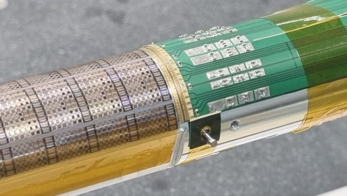Over the past few months the silicon microstrip tracker of the CMS experiment has been making steady, and rapid, progress towards meeting its next major target – installation of the complete detector in its site at intersection point 5 on the Large Hadron Collider in November 2006.

This has been especially encouraging to the CMS collaboration as the past year has seen significant problems with relatively small details in a few key components, delaying the assembly of modules and their subsequent integration into the mechanical superstructure. However, these problems have now been overcome and the subsequent assembly speed of several inner layers of the tracker has demonstrated the readiness of the teams of engineers and physicists, who had used some of the time during the pauses to refine their procedures.

The CMS tracker will be the largest silicon system ever built, with more than 200 m2 of silicon microstrips surrounding three layers of pixel detectors in a cylindrical barrel-like layout, with end-caps completing the tracking in the forward and backward regions. The construction involves teams from all over Europe and the US, who have developed components and pioneered automated techniques to manufacture modules that must withstand the stringent conditions at the heart of the CMS.
The inner barrel (see cover picture) is the responsibility of an Italian consortium. The delivery of the first half to CERN is expected this month, followed by the second half in January 2006. While tests begin on the inner barrel in a brand new integration facility, which is currently being erected at CERN, it will be joined by, and later inserted inside, the outer barrel system. This is largely the responsibility of CERN, and consists of modules arranged in rods that are being manufactured in the US by teams who have experience from Fermilab experiments. The two end-caps will complete the assembly in mid-2006; one will be built by a French team in the facility at CERN, the other by a German team in Aachen.
The remaining off-detector electronics and cooling systems are also beginning to arrive at CERN. These will allow the completed tracker to be studied for several months before it is moved to its final underground location at the centre of the CMS. Once in operation it will provide precise radiation-hard tracking for many years.
Meanwhile, September saw an important milestone for the ATLAS inner detector project with the delivery of the fourth and final Semiconductor Tracker (SCT) barrel to CERN. A few days after delivery, on 20 September, the barrel was integrated into the final configuration of the full barrel assembly.
The SCT has a silicon surface area of 61 m2 with about six million channels and is part of the ATLAS inner detector, where charged tracks will be measured with high precision. More than 30 institutes from around the world have contributed to building the component parts and structure of the SCT.
Moving outwards from the interaction region, the ATLAS inner detector comprises the pixel detector (consisting of three pixel layers), the SCT (four silicon strip layers) and the transition radiation tracker, or TRT (consisting of about 52,000 straw tubes).
During 2004 a team of physicists, engineers and technicians from several SCT institutes set up one of the largest silicon quality-assurance systems ever built (corresponding to about 15% of the final ATLAS readout system), which was capable of analysing the performance of one million sensor elements on nearly 10 m2 of silicon detectors simultaneously. Using this system to test barrels prior to their integration, the team found that more than 99.6% of the SCT channels were fully functional, an exceptionally good performance that exceeded specifications. The work is taking place in the SR1 facility at CERN, which was purpose-built by the ATLAS inner detector collaboration and houses a 700 m2 cleanroom.
This month the ATLAS inner detector teams will integrate the silicon tracker with the barrel TRT and test their combined operation in SR1. At the end of this year the SCT end-caps will arrive at CERN, and then be inserted into the TRT end-caps during spring 2006. In March 2006 the inner detector team will then place the barrel inner tracker in a steel frame and transport it to the ATLAS underground cavern. The entire integration process is scheduled to be finished at the end of 2006, when the all-important pixel detector will be inserted in the tracker.
The whole assembly of the inner detector will sit in the 2 T magnetic field of the central superconducting solenoid, which has a diameter of about 2.5 m. This will deflect the tracks of charged particles passing through the inner detector. The much larger air toroid magnet system (see CERN Courier cover picture September 2005) is to deflect the tracks of muons, which penetrate to the outer reaches of the huge ATLAS detector.





